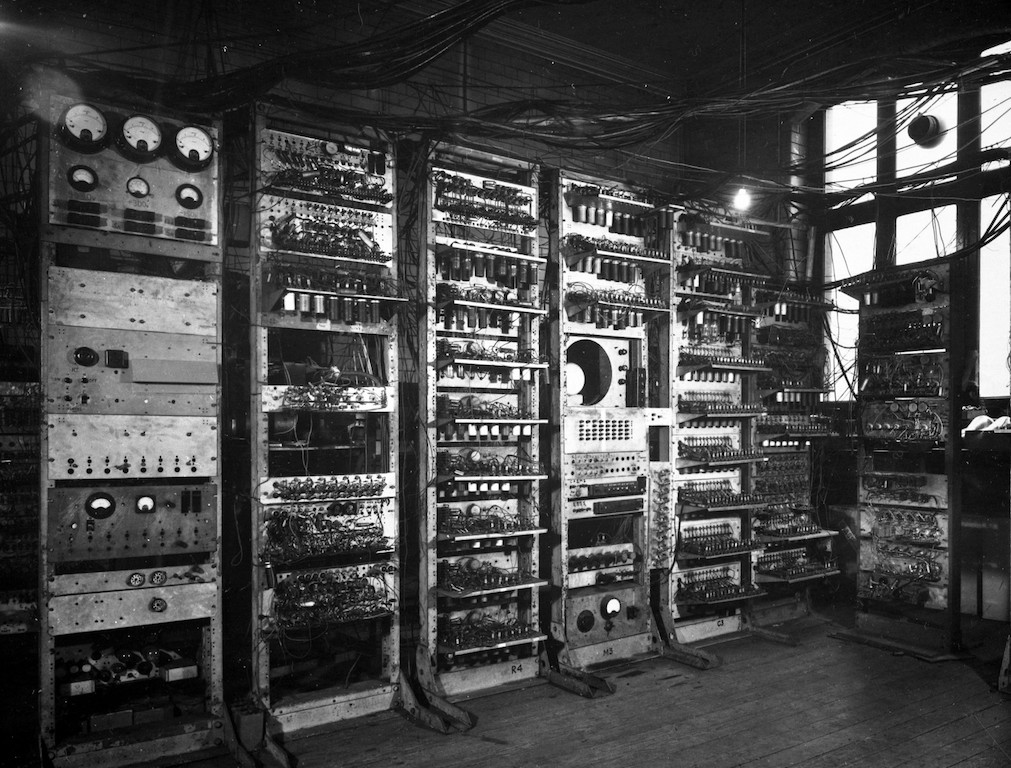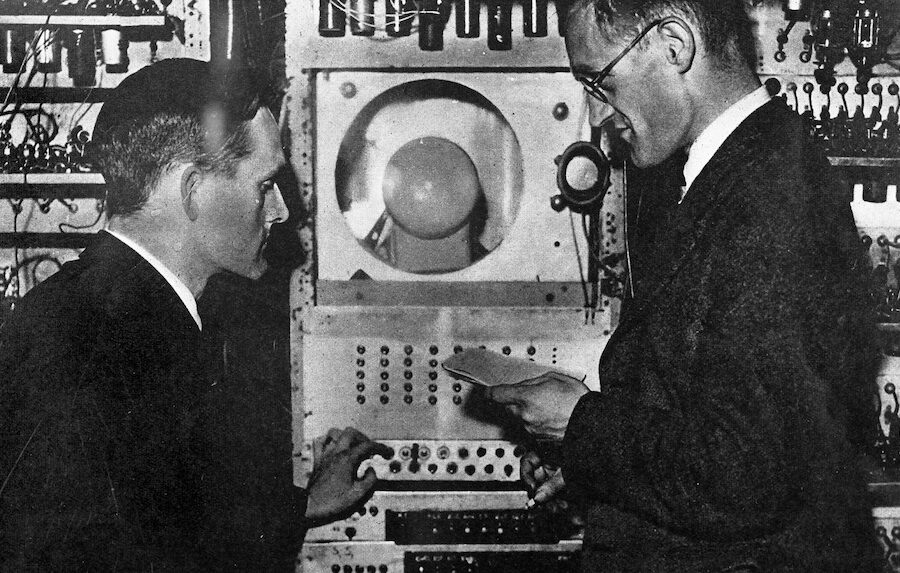Main image: Freddie Williams and Tom Kilburn, the inventors of the Baby shown programming the Manchester Mk 1 computer built by extending the Baby. Photograph courtesy of University of Manchester
Seventy-five years ago today, on Monday 21 June 1948, the first stored program computer in the world ran its first job. It was an experimental machine built in Manchester by a team lead by Sir FC Williams and Tom Kilburn: its purpose was to test the new Williams tubes developed for random-access storage to replace serial-access delay lines. Nicknamed the “Baby” it had a 32×32 bit word with keyboard input and it ran a 52 minute factoring program.
Williams and Kilburn had come from the Telecommunications Research Establishment (TRE) to Manchester in 1946. Kilburn published a paper outlining the machine in 1947 and they set to work to build it with an expanded team including ex-TRE colleagues.
Mark I

The Manchester team went on to develop the Mark I which first ran in April 1949. Manchester was forging ahead in computer development registering 42 patents between 1948 and 1950, according to Simon Lavington’s Early British Computers, on which the history part of this report is largely based.
The Mark I was last used in 1950 and had been used by DG Prinz for guided-weapons development for Ferranti, just down the road. The Government Chief Scientist, Sir Ben Lockspeier, had seen the Mark I in October 1948 and contacted Ferranti to build copies with a five-year grant of £35,000 a year from November that year. Ferranti made nine Mark Is and Mark I*s between 1951 to 1957. This gave Manchester another first: the first computer built on spec and then sold. Another first was soon around the corner when Alec Glennie wrote for the Mark I the first autocode for his own use.
Mark II
Yet another milestone was past first at Manchester in 1952 when Kilburn and others developed the Mark II which was the world’s first implementation of floating point in hardware.
Ferranti later picked up the Mark II design and turned it into the Mercury range. The Mercury was the first computer the Met Office bought after using both the LEO and the Mark I on a bureau basis, Catherine Ross, Archivist at the Met Office told AIT in September 2022.
There’s more firsts to come for Manchester: the first transistor computer was built by a team led by Kilburn in November 1953: it used a magnetic drum for storage. Its design was picked up by Metropolitan-Vickers, another Manchester neighbour, and turned into the MV950 by 1956, making it the first commercially available transistor computer in the world.
The firsts do not stop there: Kilburn and his team went on to build the MUSE with a micro-second engine. He worked with Ferranti to help design the ATLAS, launched in 1962 with its pioneering virtual storage and paging system, thus introducing the decorous term “thrashing” to the computing vocabulary. Its operating system, designed by David Haworth, said by some to be the first real operating system.
The Manchester team went on the build the MU5 which made a forceful contribution to ICL’s new range, the 2900. Martin Campbell-Kelly says of the new range design: “Without any question, the new range architecture was masterly. It was elegant, efficient, not in the least baroque, and in advance of anything offered by any other manufacturer (and this arguably remains true in the late 1980s).”
That is at least eight other firsts in computer engineering rippling out from that day 75 years ago.
Ripples from the Manchester Baby
The ripples from Manchester continued to the widely popular Raspberry PI and the world’s platform for mobile IT: the ARM RISC processor design.
Pete Lomas, co-designer of the Raspberry Pi, remembers his time at Manchester: “I was desperate to have my own computer, but obviously they were just not available. So the only solution was to build your own. I managed to get a subscription to Byte magazine, which was one of the very early hobbyist magazines I call it from, from the US.
“But we also created a thing called the Manchester Computer Club, so I was a founder member of that, and we used to meet in the chaplaincy just right next to the computer building. And we used to talk about, you know, the idea of building our own computers. Some went down the 6800, the 6809 route; I went the Z80 route. But it was the camaraderie of actually building something unique for yourself.”
Tension and competition
Steve Furber, co-designer of the ARM microprocessor first at Acorn, recollected on the long rivalry between Manchester and Cambridge which still was around when he went to Cambridge in 1971 and later to Manchester: “I was born and brought up in Manchester, and I’ve worked there for more than quarter of a century.
“I spent 20 years in Cambridge, at the university and then at Acorn. And when I came to Manchester, in fact, that was really the first time that I sensed this historic tension. There was a bit of competition and some ill-feeling I would say, going back to the very early history of computing.
“Some of that boils down to who really built the first stored-program computer? The historic answer is the first operational stored-program computer was in Manchester, but it was rather small and prototype-y and not very useful, and needed expanding a bit. And the first usable stored-program computer was the one Maurice Wilkes built, the EDSAC, in Cambridge.
“Of course, Williams and Kilburn were not actually trying to build the first stored-program computer at all. They had this idea for memory based on cathode ray tube storage, which they had used during the war in analogue form for radar and their question was: can we now turn this to digital purposes?
“They built a very simple computer around it, as their idea of the easiest way to test this concept. But Manchester can certainly claim the first operational stored-program computer, and Cambridge can clearly claim the first stored-program computer that could support a sensible user service. And both of those are important.”
